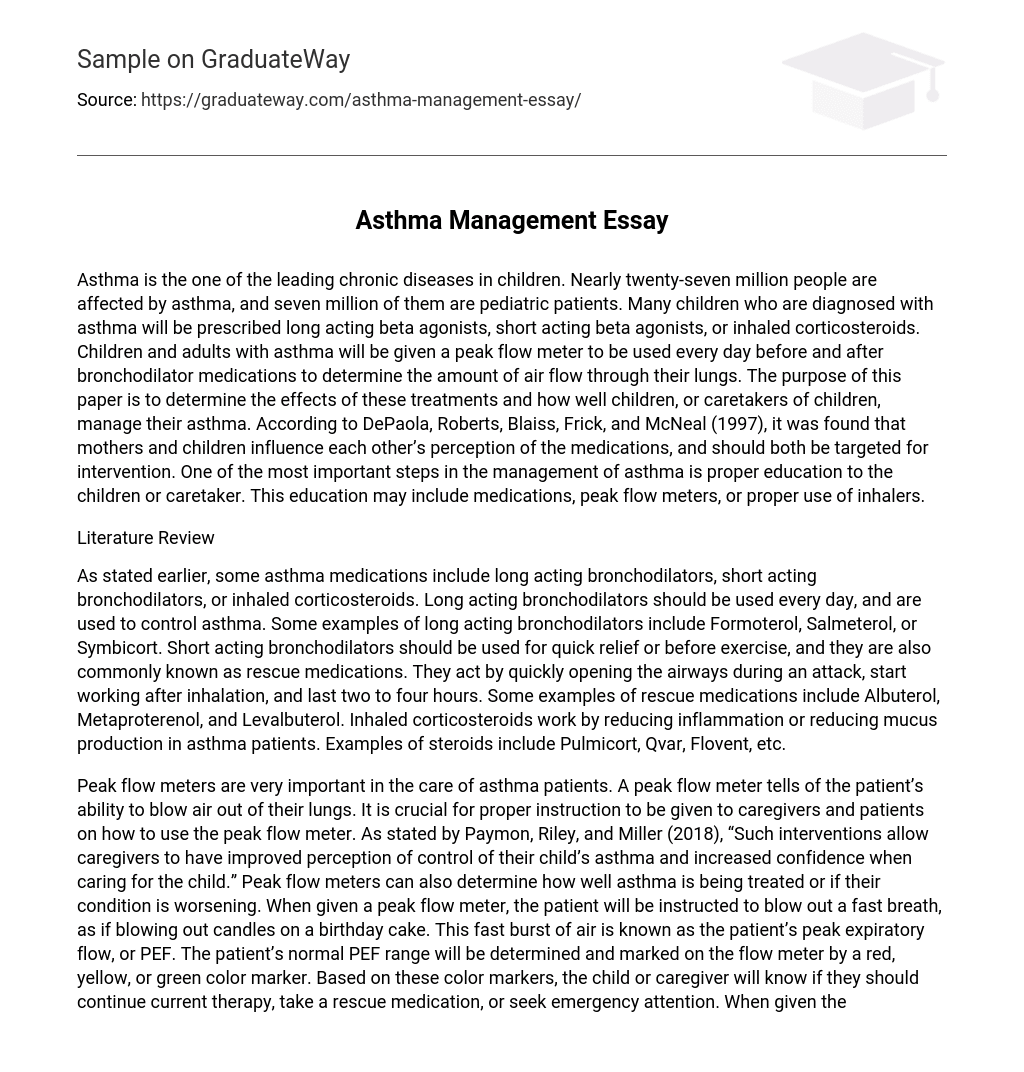Asthma is the one of the leading chronic diseases in children. Nearly twenty-seven million people are affected by asthma, and seven million of them are pediatric patients. Many children who are diagnosed with asthma will be prescribed long acting beta agonists, short acting beta agonists, or inhaled corticosteroids. Children and adults with asthma will be given a peak flow meter to be used every day before and after bronchodilator medications to determine the amount of air flow through their lungs. The purpose of this paper is to determine the effects of these treatments and how well children, or caretakers of children, manage their asthma. According to DePaola, Roberts, Blaiss, Frick, and McNeal (1997), it was found that mothers and children influence each other’s perception of the medications, and should both be targeted for intervention. One of the most important steps in the management of asthma is proper education to the children or caretaker. This education may include medications, peak flow meters, or proper use of inhalers.
Literature Review
As stated earlier, some asthma medications include long acting bronchodilators, short acting bronchodilators, or inhaled corticosteroids. Long acting bronchodilators should be used every day, and are used to control asthma. Some examples of long acting bronchodilators include Formoterol, Salmeterol, or Symbicort. Short acting bronchodilators should be used for quick relief or before exercise, and they are also commonly known as rescue medications. They act by quickly opening the airways during an attack, start working after inhalation, and last two to four hours. Some examples of rescue medications include Albuterol, Metaproterenol, and Levalbuterol. Inhaled corticosteroids work by reducing inflammation or reducing mucus production in asthma patients. Examples of steroids include Pulmicort, Qvar, Flovent, etc.
Peak flow meters are very important in the care of asthma patients. A peak flow meter tells of the patient’s ability to blow air out of their lungs. It is crucial for proper instruction to be given to caregivers and patients on how to use the peak flow meter. As stated by Paymon, Riley, and Miller (2018), “Such interventions allow caregivers to have improved perception of control of their child’s asthma and increased confidence when caring for the child.” Peak flow meters can also determine how well asthma is being treated or if their condition is worsening. When given a peak flow meter, the patient will be instructed to blow out a fast breath, as if blowing out candles on a birthday cake. This fast burst of air is known as the patient’s peak expiratory flow, or PEF. The patient’s normal PEF range will be determined and marked on the flow meter by a red, yellow, or green color marker. Based on these color markers, the child or caregiver will know if they should continue current therapy, take a rescue medication, or seek emergency attention. When given the peak flow meter, the child should also be given a diary. The diary’s purpose is to chart the PEFs every day and list how the patient is feeling in order for the medical team to determine if the proper management of the patient’s asthma is being achieved.
The most common method used to treat asthmatic symptoms is a metered dose inhaler. It is very common that many children are not taught the correct way to use their inhaler, which leaves the child getting little to no benefit at all from their medications. To receive optimal dosage of the medication, the patient must shake or prime their MDI, take in a deep breath, and then hold their breath for at least ten seconds. Many children may have trouble actuating the inhaler and inhaling at the same time, so many are also given a spacer. A spacer holds the medication so that optimal dosage may be achieved. A child using an MDI without a spacer may not be achieving optimal particle deposition into the airways. Benidictis and Selvaggio (2003) state, “It is traditionally accepted that particles larger than 5µm are mostly deposited in the oropharynx and upper airway as a result of inertial impaction; particles ranging from in the 1–5µm are efficiently deposited in the lower respiratory tract (‘respirable’ fraction); particles less than 1µm are inspired and then expired without ever settling on the airway.”
Conclusion
Parents, or caregivers, play a crucial role in the management of asthma in pediatrics. It is important to thoroughly instruct the parents and patients all that is needed to know about asthma medications, MDIs, and peak flow meters. They need to be assisted in a management plan and know when and where to go in case of an exacerbation of a pediatric patient’s condition. Many pediatric patient’s conditions may decline due to improper treatments. This will increase their amount of doctor visits or hospital stays, increasing stress on the patient or family, and lead to further worsening of the patient’s condition.





